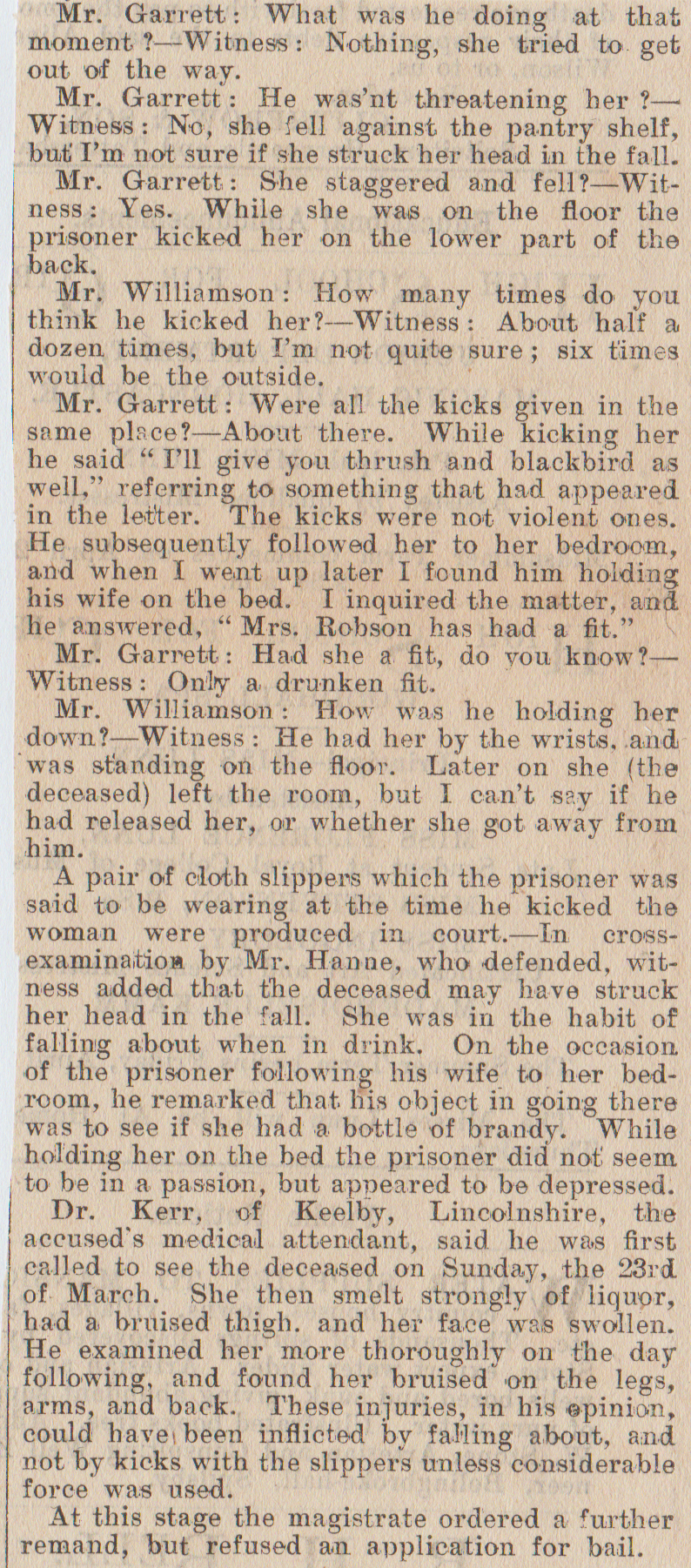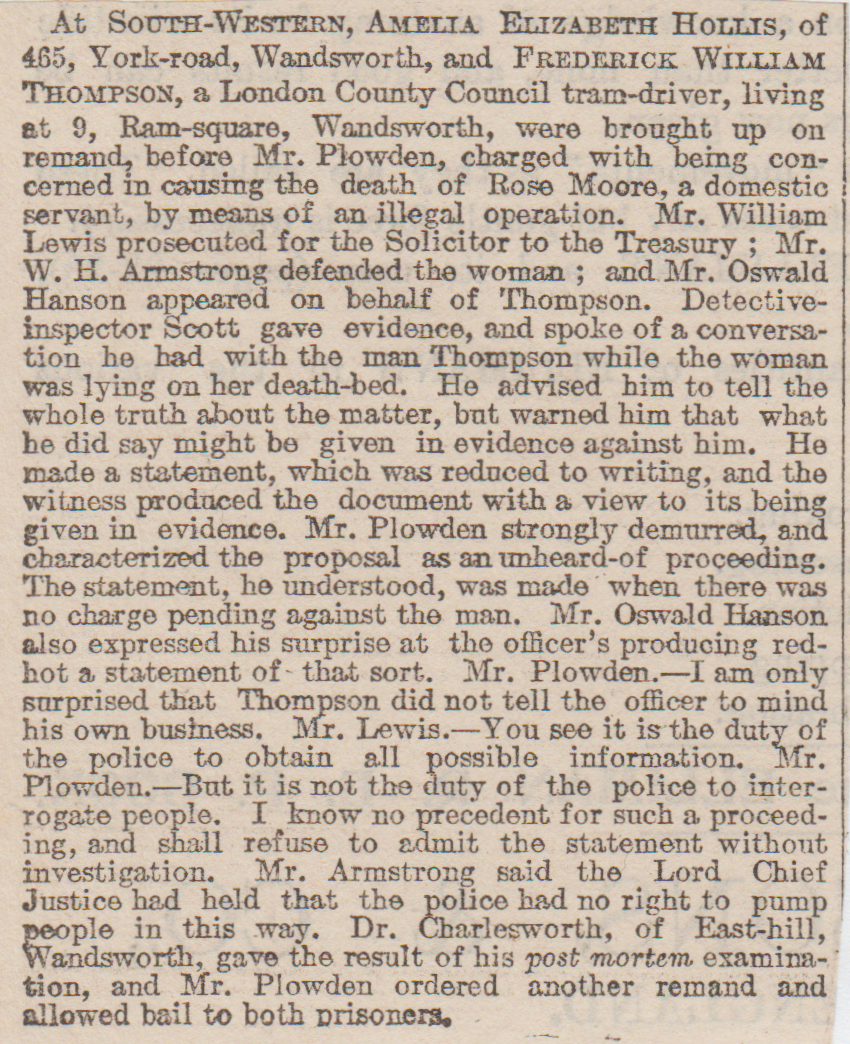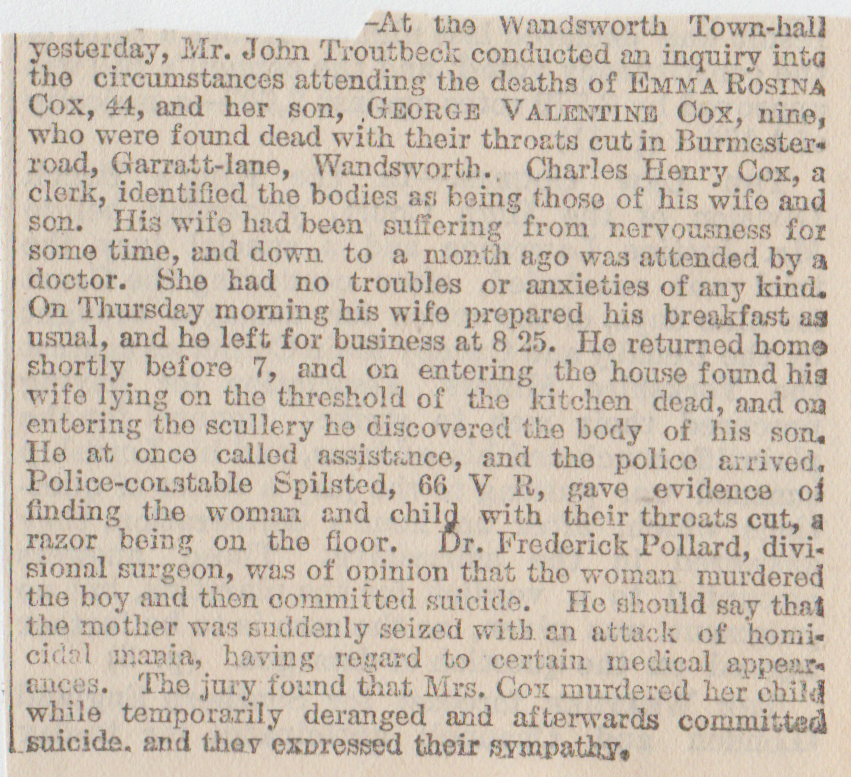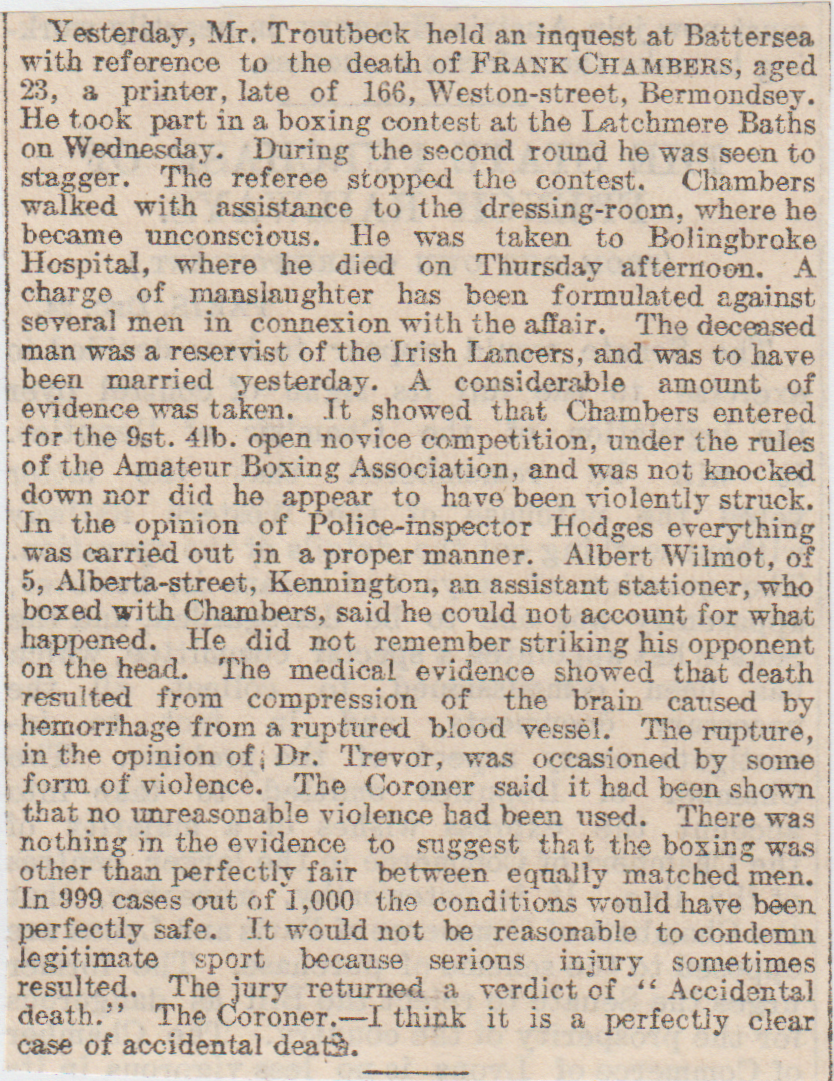Liverpool
murder
Wandsworth
1/ Wandsworth Boating Deaths, April 1883


2/ Tooting Cemetery, September 1896 (Fight at Funeral)
Ellen Donovan, a charwoman, went with the man she lived with, to his son’s funeral. The relatives at the funeral didn’t really like her and an argument ensued, followed by a punch-up. Donovan was a well-built woman, but she was punched and had her clothes torn to shreds. George Askew was charged with assaulting her (as well as the other stuff), he kicked her when she was lying down and broke one of her rib’s.
3/ Wandsworth Gaol, December 1882 (Execution Goes Wrong)
I don’t know if I can say that I feel sorry for a murderer, but to go the way this guy did was uncalled for and they should have taken more care than they did. I think it was William Marwood who hung him and he was a Lincolnshire celebrity at the time, as he was the hangman. Anyway, the story goes like this- In August at Camberwell, Charles Taylor killed his missus by cutting her throat with a razor. He did it at No 2, Tustin Road, Old Kent Road and his fifteen-year-old daughter went out for an hour, then arrived back, she saw her Dad leaning over the body, drenched in blood, then telling her that he did it because she kept on nagging him. He had also slit his own throat, in a bid to kill himself and not face the judge, but he was saved and recuperated in hospital.
It was now time for him to face the hangman, as he was found guilty when he had got better and they had obviously forgotten that he had gashes on his neck, that would affect things as they were still healing. When he dropped through the trap-door, the head was nearly ripped off the body.
4/ Putney Heath, (Human Remains) August 1875
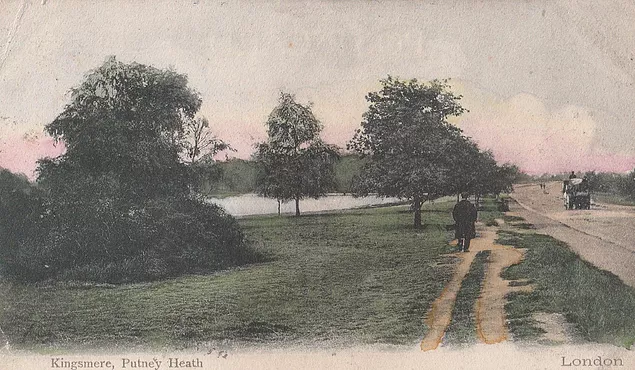
P.C.William Payne was on duty on Putney Heath, when he stumbled on the decomposed remains of a man in the bushes. When the body was being moved when the head of the deceased dropped off. Payne had to cut back some of the bushes and shrubs to get to the corpse and it was suggested at the inquest that the deceased would have had to crawl there. He bore no marks of violence. On his person was a Remington pistol and six cartridges, plus a handkerchief with blood spatter on it, some keys, an eye-glass and some small change. The post-mortem examination proved that the body had been there approximately three weeks. The man’s clothing, height etc, give him a similar description to Alexander Collie, who was meant to be in court on charges of fraud but had failed to appear. Then another gentleman came to identify the Remington, which he said he lent to Thomas Grant of the London Scottish Volunteers, who had just been sacked from his City job. Police were satisfied it was the body of Thomas Grant.
5/ Beaufoy Road, Battersea, June 1891

6/ Wandsworth Lunatic Asylum Fatality, March 1854
An inmate of the Wandsworth Lunatic Asylum was scalded to death by another patient. Both inmates were momentarily left to their own devices by their attendant in the bathroom, when one named Poyle, held Alfred Gibson under the boiling water. He died soon afterwards.
7/ Putney, August 1856
Six-year-old George Wood Downe was watching a swing was being erected in a field near the Half Moon Inn in Putney. He was with a group of kids playing nearby, when a twenty-foot high triangular support made of iron, suddenly fell over, crushing the boy underneath. His head took the brunt of the force and death was instantaneous. “Accidental Death” was the jury’s verdict.
8/ Wandsworth Poisoned Children, June 1885

9/ Putney/River Thames Drownings, January 1885
Yesterday two boats were in collision in the Thames off Putney. The occupants of one of the boats, five in number, were precipitated into the water and two- Mr Mackenzie, a Twickenham gentleman and the Reverend Mr Garnish, who endeavoured to save him, were both drowned.
10/ Wandsworth Common, August 1844
Amelia Alfred, residing at Wandsworth, tried to drown herself and two illegitimate children in a pond on Wandsworth Common. She tied them around her waist, then jumped into the pond, but it is fairly shallow, so she laid on her back in order to drown them. A lad and her brother plus other passers-by dragged her out and she was restored back to life. Alfred is to be classed as insane, due to great stress.
11/ R.Bell & Co Explosion, Wandsworth, April 1885

12/ Surrey Lunatic Asylum (Murder/Manslaughter?) June 1856
Dr Charles Snape, the late superintendent of the male side of Surrey Lunatic Asylum, was charged “that he, on the 9th of April last, did unlawfully and feloniously kill and slay one Daniel Dolby”, an inmate at the asylum. Dr Snape was in the practice of giving shower baths to patients when one of them lashed out and smacked him one. The doctor gave the order to keep him in the bath for half an hour, telling the attendant to keep an eye on him. This was complied with for twenty-eight minutes, but twenty minutes after he came out, he was dead. The case was adjourned. (Are these ice baths?)
13/ Battersea Child Cruelty, January 1899
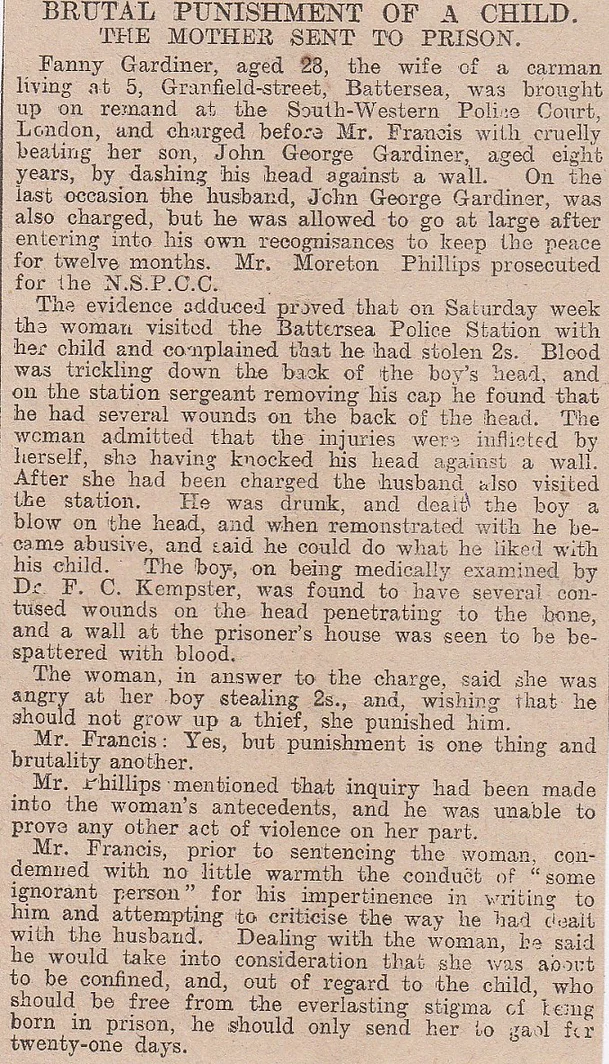
14/ District Railway, March 1892 (Pickled Baby)
The dead body of a newly-born child was discovered in a first-class carriage under the seat on the District Railway. This is not an unusual story on this website as you might think, but this child was pickled in a jar. Tests reveal that the child was still-born and the liquid in the jar was some sort of spirit. There were no marks of violence on the baby.
15/ No.12, Fountain Road Familicide, Tooting, March 1895
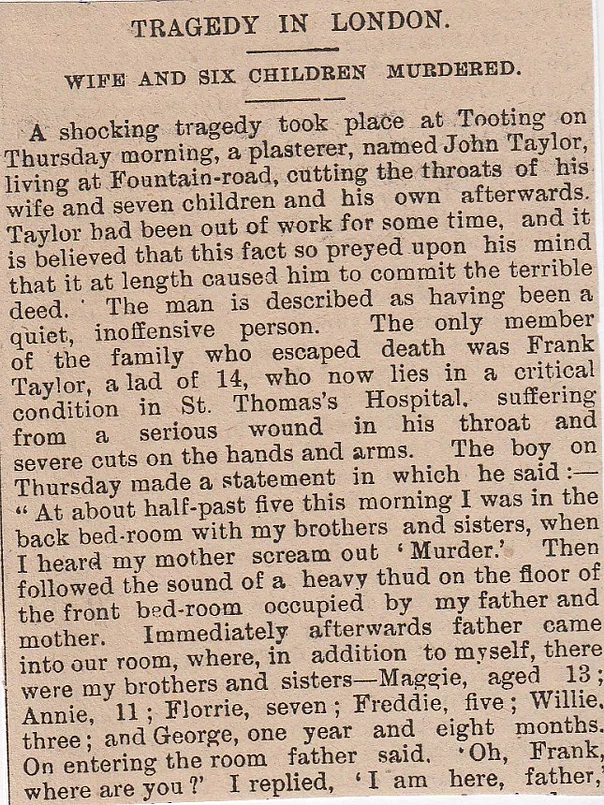

16/ Wandsworth Gaol Execution, June 1895

17/ Clapham Junction (Fatal Accident) August 1870.
18/ Clapham Common Suicide, September 22nd 1870.
September 24th, 1870. Cedars Road is still there, opposite Clapham Common North Side.
19/ Battersea Wife Manslaughter, April 26th, 1902. (Brocklesby Farmer Kills Wife)
20/ Battersea Wife Manslaughter, May 17th, 1902. (The Inquest and Verdict)
21/ Sad Fatality of Firework Cracker, Battersea. November 1903 (Culvert Road is still there)
22/ Sad Death due to Botched Abortion, Wandsworth. November 1903
23/ Death of a Child From Improper Feeding, Replingham Road, Wandsworth. March 1904
24/ Child Murder in Putney, March 1904. (The actual term is Neonaticide for a child less than a day old that is killed)
Mildred Cole, a young domestic servant, was brought from the Wandsworth Infirmary, where she had been lying ill, to answer a charge of murdering her male infant child on the 11th of March. The prisoner was employed as a domestic at a house in Disraeli Road, Putney. Shortly after its birth the infant was strangled with the aid of a piece of tape and thrown among the contents of the prisoner’s clothes box, where it was found devoid of clothing. The mother admitted her guilt and, after evidence had been given, was remanded.
25/ Child Dies From Want, Wandsworth. January 1904 ( 37 Aslett Street is still there)
26/ Child Murder/Suicide, Burmester Road, Wandsworth. February 1904
27/ Infanticide in Wandsworth, March 1904
28/ Barrister Stabbed by Girlfriend, Wandsworth Common. January 1905
29/ Boxing Fatality at Latchmere Baths. December 1906 (Was Latchmere Baths where Latchmere Leisure Centre now stands, on Burns Road, off Latchmere Road?)
30/ Body Found in River Thames off Battersea. December 1880
31/ Fatal Accident at Battersea Railway Station. December 1880
Barnet
1/ Colney Hatch Lunatic Asylum Fire, Barnet, January 27th, 1903
A massive fire swept through the Lunatic Asylum at Colney Hatch (now Friern Hospital) on this day in 1903. Altogether fifty-two women perished in the fire and the funeral was attended by thousand’s who lined the streets. Thirteen hearses took the fifty-one coffins to New Southgate Cemetery. Colney was the largest of the London asylum’s, with a total of 2500+ inmate’s (900 males & 1600 females). It cost £400,000 to build and was erected in 1851. The staff of fifty medical officer’s, one hundred and ninety male servant’s & two hundred female servant’s, plus fifty groundsmen and workers. (Fire was in Ward X5)
November 24th, 1903. Colney Hatch Fire Memorial.
2/ Colney Hatch, July 1878
Elizabeth Berwick, a 46-year-old inmate whose husband worked as an official at West India Docks, Limehouse and who had been here for more than four years. She had been brought to the establishment because of her suicidal tendencies. She was found hanging by her bedsheets from the bars of the windows, she was cut down but was barely alive, and died within the hour. She had tried the same thing at Hanwell Lunatic Asylum a number of times. Not a surprising verdict in an asylum-Committed suicide while of unsound mind.
3/ Colney Hatch Asylum Murder, April 1882
Henry Sands, alias Williams was killed in Colney Hatch Lunatic Asylum by fellow inmate Samuel Fereday. At four o’clock the deceased was working in the farm area when an attendant named Hill heard a cry and he saw Fereday legging it away from the body. His shovel was next to the body. A witness asked him what had he done and he said “nothing”. Strangely though Fereday was a sedate patient, no trouble at all but had complained of headaches that day. It took only five minutes from the act being committed to the death of Sands. Fereday said the patients had been “guying” him and Sands as well, they would chew tobacco and spit the juice in his beer. They said “they would have my head,” he told them afterwards and this was his revenge for being goaded and made fun of. He struck him four times with a shovel with serious force. The verdict was one of “Wilful Murder”.
4/ Children Die in Fire, Hendon, February 1899

5/ Finchley Child Murder, March 1877
An inquest was held on the discovery of a child’s body in a pond at Church End. Thomas Sorrell, a builders son, found the infant when he was with a group of lads, and he’d poked it with a stick and turned it over, then saw the baby’s foot. He ran to get a policeman and P.C.Izzard was nearby, and he came to examine the corpse. Dr Wright said it was badly decomposed and his approximation of time of death would be two months ago. The skull bones were separated and there was no brain or other organs, these had apparently been removed. Its arms had been tied together with twine. The lungs had putrified so there was no real evidence whether the child been murdered or ever breathed at all. What a way to go though, poor little bugger!
6/ Welsh Harp Suicide, Hendon, May 1884
Winifred Jessie Spray, a milliner by trade, killed herself on the Midland Railway. She had been a patient of a lunatic asylum twice before but had been let out and been given the all-clear. Spray left Childs Hill, where she was residing at the time, and went to Kilburn in search of a job. The morning after her job-search, she was found in a mutilated condition on the railway tracks not far from Welsh Harp. A scrap of paper was found, and she’d written the following words:-
“I am mad-everybody knows it. I am going to the bottomless pit. It is an awful thing. It is a rash act. I am going now”.
7/ Welsh Harp Reservoir, Hendon, February 1909 (Skating Accident)
A tragic skating disaster ended with five people losing their lives at the Welsh Harp Reservoir in Hendon. Three men and two boys were in the centre of the lake, about 100 yards from the bank when the ice cracked and they all fell into the freezing water. Few people were in the vicinity but some brave souls made the effort to save them. One bloke with a lifebelt on tried to get through the ice to help them but all to no avail. All that could be seen was two hats floating on the Reservoir surface. Three men jumped in a boat and tried to get them with grappling hooks and they brought up the body of a soldier and a young lad. Five doctors had rushed to the scene but all efforts to restore animation to the bodies were useless.
8/ Childs Hill Suicide, February 1891
A Midland Railway inspector named William Warriner was strolling the railway line between West End Station and Childs Hill when he came across the mangled body of a young girl. The head was caved in and the brains were on the other side of the rails. Childs Hill Station officials found the foot of the girl, which had been discovered twenty yards from the body. At the post-mortem examination, they found an address on the undergarments, and this to her being identified as Kate Carter aged 15, a domestic servant. She lost her job a while back and was staying at a mate’s house at 25, Netherwood Street, West Hampstead. She went to get a character reference from an old employer of hers but wasn’t seen again until she was found on the tracks. Her footprints were next to the fence which means she’d climbed over it, to get to the railway. It seems it was suicide, and the Scotsman passed this area at 7:50, and was travelling at 40 m.p.h., so this was never going to fail.
9/ New Barnet Suicide, July 1889
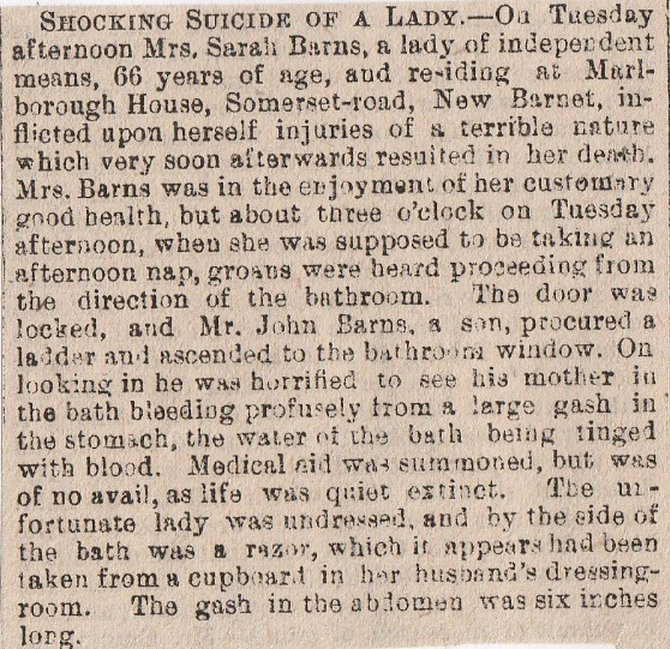
10/ High Street Suicide, Barnet, July 1888

11/ Colney Hatch Suicide, August 1903
A suicide in an asylum is likely to have some strange variations on how it is committed. Henry Seaton, aged 35, was habitually trying to kill himself. He tried to tear out his own tongue several times but two or three months ago, he told staff that he’d swallowed a large piece of wood. They dismissed this as the rantings of a madman. The post-mortem of his body, revealed a chunk of wood nine inches long in his stomach with one end puncturing the lining, this caused inflammation then an abscess, which in the end caused his death. Doctors said that if they had listened to him in the first place they could have operated and saved his life. The fact that he’d swallowed such a huge piece of timber and lived for a few months is in itself a minor miracle. The wood went into the stomach instead of lodging in his windpipe. Seaton’s sister mentioned at the inquest that he tried to commit suicide by swallowing a snuffbox, but that failed.
12/ Colney Hatch Asylum (Mistreatment of a Patient) May 1860
Yep. Colney Hatch again! This is the mistreatment of a patient by an attendant which caused his death. William Swift was found injured, suspected to have been caused by two attendants, Vivian and Slater. He had eleven ribs and his breastbone broken, and Sam Clark told the hearing “On the 12th of May, I saw Swift brought in from the exercise yard, by Mr Slater and Mr Vivian. They took hold of him by the arms. Vivian had hold of his collar. He said, “Don’t take hold of me, and I will go anywhere with you”. Vivian then let go of his collar and took hold of his arm. They took him into the ward and tripped him up. They threw him on the floor and ill-used him. Vivian kicked him and Slater punched him. They then got him up and took him to the door of the padded cell, where they undressed him and pushed him in. He was calling so that they must have heard him all over the exercise yard. He said, “Kill me at once; don’t kick me like that”. Slater had been out with some of the patients and when he came in, Vivian said to him “I’ve been waiting for you, I can’t keep Swift out of the ward”. Slater said “Take him at once”, and they took him in. Slater got us to bed earlier than usual that night.”-(What was the outcome?)
13/ Colney Hatch Asylum Murder, November 1861
A case of murder was the unlikely scenario at Colney Hatch this time. Joseph Bigg aged 28, was an inmate of the Asylum and he resided at No 14 Ward, where the dirty and noisy patients were, and they had attendants watching their every move. He was found by Sam Rickman an elderly inmate on Tuesday afternoon with a blue handkerchief tied around his neck. He was face down on the floor next to a press and Rickman kept mumbling “My poor boy is dead”. Rickman was like a father to him, watching him and feeding him, and he told staff and police that he saw a patient named Skinner strangle Bigg. Skinner said he’d been elsewhere in the asylum and denied having anything to do with his death. Unfortunately, in an asylum, nobody’s word can be taken for granted or used in evidence because they are all stark raving mad in the eyes of the law. This was the case here. It was just Skinner’s word against Rickman’s, and the verdict was that the deceased had been “strangled by a person or persons unknown”.
14/ Silk Bridge near Hendon, January 1880

15/ New Barnet Child Murder, April 1895
The body of a little girl, Lydia Hill, only six and a half years of age, was discovered in a field in New Barnet. She died from loss of blood and shock to the system, as a result of terrible injuries inflicted in the act of rape, in what seems to be a frenzied attack. Police have already arrested a man on suspicion of her murder. Ada Baker and Hettie Julian, friends of Lydia, identified the man, whose name is Osborne. Detective Inspector White of Scotland Yard is going to charge him with causing the death of a child and with rape.
16/ Barnet Suicide, January 1890
Sunday nine a.m., and the stationmaster at New Barnet, Mr Redford, told East Barnet police that a man’s body had been found on the embankment near to Hadley Woods bridge. An officer went to the scene of the suicide, and the first thing that was obvious was that he’d been dead for a number of hours. He was smartly dressed, his head was near to the train tracks with a gun in his right hand. Above his right ear was the entry wound, and the positioning of the body suggests that he meant to shoot himself, then for the body to lay across the rails, and to make certain, have a train run over him. He was wearing a gold ring, gold cuff-links, a bit of cash, crocodile skin pipe, etc, all give the impression that he was of good breeding. A calling card with the name “Austin H.Turner” was also in his pocket, and he was about forty years of age, 5 feet 8 inches, with brown hair, and a dark moustache. (Who was he ?)
17/ Barnet Railway Fatality, December 1870
18/ Abandoned Child near Barnet, October 1870 (Middlesex Sessions- October 12th)
19/ Murderer’s Brother Found Dead in Garden, East Finchley. April 1905
20/ Cyclist Killed on Hermitage Lane, Child’s Hill. November 1907 (Hermitage Lane is still there)
21/ Female Corpse Found in a Pond, Hyde Common, Hendon. December 1880
Barking & Dagenham
1/ Barking Creek, August 1871 (Discovery of Skeletons)
Workers at the City of London Gas Works near Barking Creek have dug up adult human skeletons from the foreshore of the Thames, below high watermark. The remains, all well preserved, look to have been hastily buried near each other. A medical man who studied them suggests they have been buried at least fifty years. Just below the opening made for the Dagenham Dock are some remains of an ancient forest, which at one time occupied the river bed. The root’s and trunks are disclosed at the low spring tides. (Who are they?)
2/ Barking Child Murder, January 1899

3/ Barking, February 1899

4/ River Thames Drownings, near Barking, February 1899 (Rose Hill)






